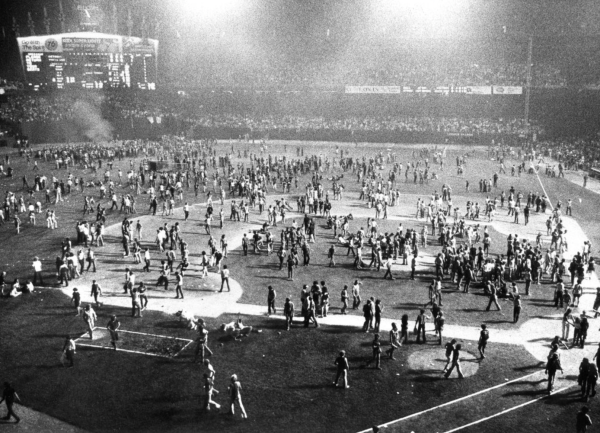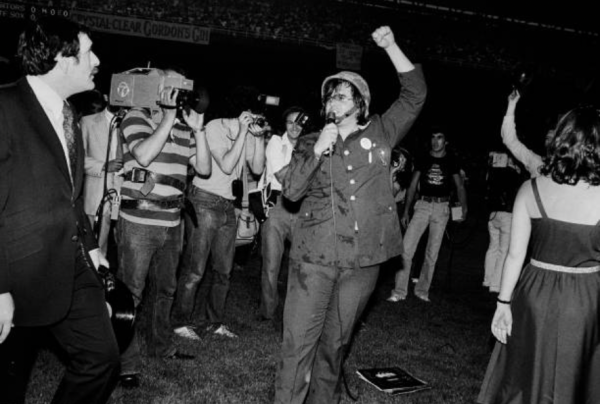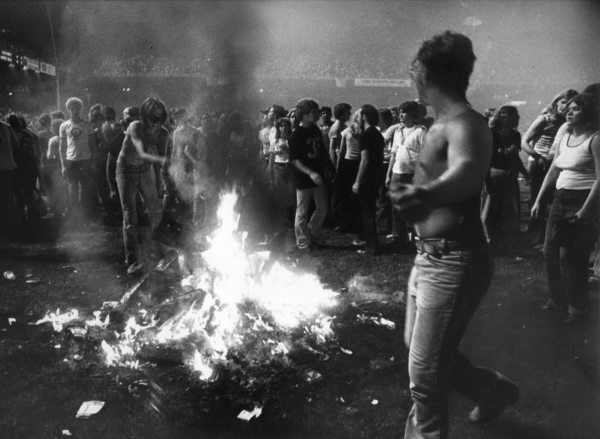The short answer is no.
Disco, both as a genre and subculture, began in the waning days of 1960s counterculture. In underground bars, parties, and clubs, disco was especially liberating for the LGBTQ+, Black, and Latino communities. Amid upbeat dance music, people could express themselves in a space beyond the law and public perception.
A law that made same-sex dancing legal passed in New York City in 1971, but not without criticism. People held social and religious beliefs that viewed homosexuality as morally wrong. They believed that legalizing same-sex marriage would undermine the traditional definition of marriage and family structure.
Studio 54, a nightclub and discotheque in New York City where people were free to express themselves without judgment, was the ultimate hub for liberation and expression as “a playground for sex, drugs, and disco.” Celebrity frequenters included David Bowie, Mick Jagger, and even a young Drew Barrymore.
“Saturday Night Fever” starring John Travolta hit the big screen in 1977, placing a huge spotlight on the Bee Gees, a disco group formed in 1958 by brothers Barry, Robin, and Maurice Gibb in Australia, with the majority of the soundtrack featuring their music. Disco’s popularity skyrocketed after the movie came out, but not everyone received it so kindly.
On July 12, 1979, a radio promotion drew a crowd of about 45,000 people to Comiskey Park in Chicago for a double-header of the White Sox against the Detroit Tigers. The radio station, WLUP 97.9, promised callers 98 cent tickets if they brought a disco record to the ballpark to be blown up in a dumpster in between games. July 12 was also half-price “Teen Night.”
The face behind the movement was Chicago-based DJ Steve Dahl. In the previous year, Dahl had been dropped from his former radio station, WDAI, once it switched from rock to disco.
“He reinvented himself at rival station WLUP as an anti-disco culture warrior who encouraged his followers, the Insane Coho Lips, to besiege and occupy disco nights in the city with the rallying cry ‘Disco sucks!’” according to the BBC. The Insane Coho Lips was the name created by Dahl for his anti-disco army.
In between the games, Dahl himself triggered the explosives, causing about 5,000 fans to storm the field, steal the bases, and set bonfires until riot police forced them to disperse. The field was destroyed in the process, forcing the White Sox to forfeit the second game.


Barry Scott, an Emerson alum and host of “The Lost 45s” radio program, said despite the fervor of the disco counter-culture movement, the soundtrack to “Saturday Night Fever” continued to dominate, winning Album of the Year at the Grammys in 1979 and spawned five big hits—among those, “More Than a Woman,” “How Deep Is Your Love,” and most famously, “Stayin’ Alive.”
“‘Saturday Night Fever’ was a huge-ass movie,” Scott said. “I mean, the soundtrack is still probably one of the best-selling albums of all time. It was number one for 20-something weeks.”
Scott was only about 16-years-old at the time of Disco Demolition Night, but he recalls the media coverage and how the perception of disco music and culture shifted after the event.
“This article that I first read in my hometown paper said—and I kid you not—‘Disco music played 24/7 to laboratory rats, made them exhibit signs of homosexual behavior,” Scott said. “I didn’t come out until I was at Emerson, but as a young gay guy, I thought, ‘Oh God, disco’s turning people gay.’”
This fear-mongering contributed to the trend of hating disco.
“People still occasionally would say, ‘Well I like your show, I just hate the disco,’ I think it’s just ingrained from the media coverage,” Scott said.
Although many discotheques closed their doors, and disco no longer dominated the top charts in the aftermath of the event, the genre won in the long run.

Disco went on to influence a myriad of different genres, namely house music, EDM, Europop, new wave, dance-punk, and hip-hop, and has seen revivals in the 21st century.
The influences of Gloria Gaynor, ABBA, Donna Summer, the Bee Gees, and Earth, Wind & Fire play a massive part in music, pop culture, and the entertainment industry today.
“Well, virtually every song you hear, whether it’s a dance song or not, is remixed,” Scott said. “I think the influence of that ‘thump, thump, thump,’ four-by-four bass beat is so easy to dance to and Americans probably are uptight about dancing. It just lets them do it [dance] easier.”
Dance and “nu-disco” music today embraces queer, Black, and Latino cultures. Disco relies heavily on rhythm and danceability, elements that many of today’s artists focus on creating in their sounds. Artists like Beyoncé, Dua Lipa, Bruno Mars, and Daft Punk create their dance beats that take on disco samples.
Disco Demolition Night may have destroyed thousands of physical disco records, but the influences of disco legends, music, and culture are very much alive in pop culture.